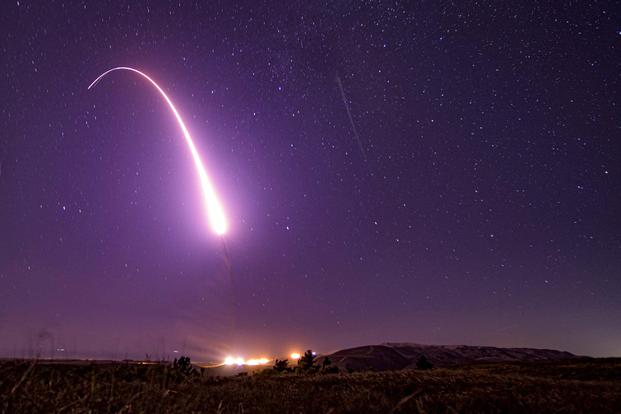The aging Minuteman III intercontinental ballistic missiles that have formed the land-based leg of the nation's nuclear deterrent triad for half a century can no longer be upgraded and require costly replacements, Adm. Charles Richard, head of U.S. Strategic Command, said Tuesday.
"Let me be very clear: You cannot life-extend the Minuteman III [any longer]," he said of the 400 ICBMs that sit in underground silos across five states in the upper Midwest.
"We can't do it at all. ... That thing is so old that, in some cases, the drawings don't exist anymore [to guide upgrades]," Richard said in a Zoom conference sponsored by the Defense Writers Group.
Read Next: Facing Sexual Assault Charges, Air Force Colonel Heads to Court-Martial
Where the drawings do exist, "they're like six generations behind the industry standard," he said, adding that there are also no technicians who fully understand them. "They're not alive anymore."
Richard rejected suggestions by several think tanks that the incoming Biden administration should consider life extensions for the Minuteman IIIs as a cost-saving measure, delaying replacement with new missiles called the Ground Based Strategic Deterrent (GBSD).
"I don't understand, frankly, how someone in a think tank, who actually doesn't have their hands on the missile looking at the parts, the cables, all of the pieces inside" can make judgments on the way forward, he said.
With new GBSD missiles built by Northrop Grumman, "we will replace a 60-year-old, basically circuit switch system with a modern, cyber-defendable, up to current standards command and control system," Richard explained.
But he had a different take on life extensions for the B-52 Stratofortress bomber fleet, saying that current modernization programs for the B-52H versions of the bomber, which can carry nuclear weapons, are "going quite well." The aircraft was developed in the 1940s and entered the Air Force inventory in the 1950s.
He said he wants to add command-and-control improvements into the B-52H modernization program but overall, "I'm satisfied with where we are with that."
According to the Defense Department, the nuclear triad's bomber force currently consists of 46 nuclear-capable B-52H bombers and 20 B-2A Spirit aircraft. The undersea leg consists of 14 Ohio-class submarines, each equipped with Trident II missiles; and the land leg consists of the 400 Minuteman IIIs.
In assessing the effectiveness of the nation's nuclear deterrent, Richard warned of Russia and China's growing capabilities and the challenges ahead for the U.S.
"What's different in the world today than it was, say, back in the Cold War [is the fact that] this nation has never before had to face the prospect of two near-peer, nuclear-capable adversaries who have to be deterred differently," he said. "Actions done to deter one have an impact on the other. This is way more complicated than it used to be."
The U.S. also must contend with the divergent worldviews of Russian President Vladimir Putin and Chinese President Xi Jinping, he said, explaining, "Putin makes decisions differently than Xi."
Richard said he has made his concerns known in several meetings with President-elect Joe Biden's transition teams. Without giving specifics, he said the meetings had "gone very well" and added that he is open to a review of the nation's current nuclear strategy, should the incoming administration find it necessary.
The 2018 Nuclear Posture Review, conducted by then-Defense Secretary Jim Mattis on the order of President Donald Trump, called for a $1.2 trillion modernization of the triad, with an estimated $85 billion going to the new GBSD missile system.
The review stated that all three legs of the triad will be vital to the nation's defense for the foreseeable future. "Eliminating any leg of the triad would greatly ease adversary attack planning and allow an adversary to concentrate resources and attention on defeating the remaining two legs," it said.
One of the review's controversial recommendations was a call for the development of small-yield nuclear weapons to be placed on ballistic submarines to counter Russia's stockpile of small-yield weapons.
Last January, the Federation of American Scientists reported that a small-yield W76-2 Trident submarine warhead had been deployed aboard the Ohio-class submarine Tennessee. The Navy declined to confirm the deployment.
Richard said he looks forward to a discussion with the incoming administration on small-yield weapons as part of a new review of the nuclear deterrence mission.
"I welcome an examination of the nation's strategy here," he said. "I recommend that, based on the threat. … The threat is moving so fast that, even given the [short] time since the last Nuclear Posture Review, [it] warrants another look at it to make sure that we still endorse our strategy, and we have sufficient capability to execute that strategy."
He said STRATCOM is "prepared to execute whatever the political leadership of this nation would like to do."
-- Richard Sisk can be reached at Richard.Sisk@Military.com.
Related: The Minuteman III, Designed for 10 Years of Use, Celebrates its 50th Anniversary













